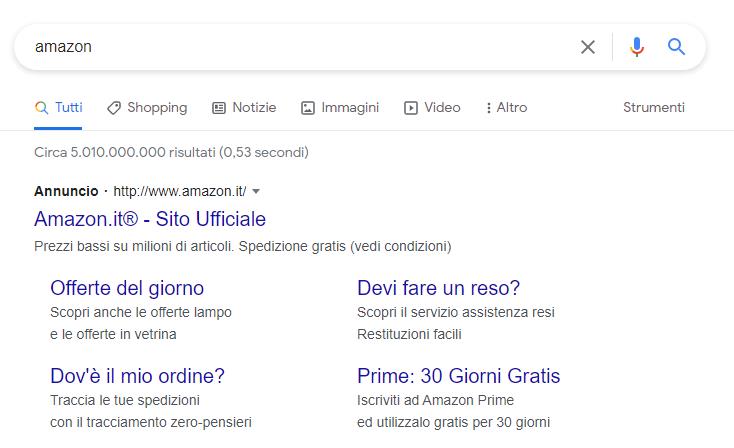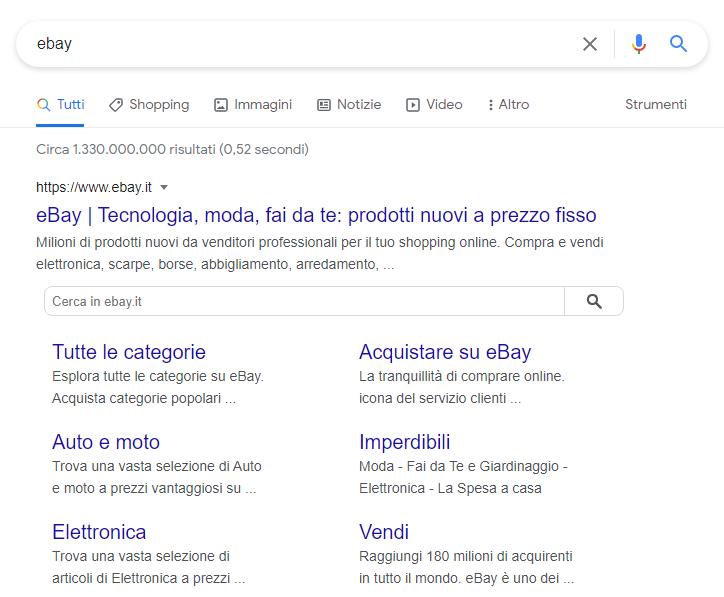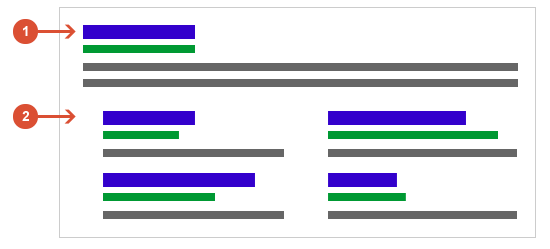How to manage or remove organic sitelinks on Google
They are called sitelinks, and they are the links that appear in SERP under some Google search results that help users enter directly into a section or a specific page of that site: they can be great to increase the CTR, but they are automatically generated by algorithms and, therefore, can point to Urls not very useful for business. So let’s find out what sitelinks are, how they can be managed and, above all, what tools and techniques we have available to remove unwanted ones and direct the search engine to more profitable addresses.
What sitelinks are on Google
The sitelink feature appears in SERP below some Google search results, presenting links to other pages or sections of a page within the same domain, placed in the first search result (they do not appear for other ranks).
These links, introduced for the first time in 2005, help users to quickly navigate to the relevant information, offering shortcuts that save time in finding the most useful destinations.
Types of sitelink
There are several types of paid sitelink: for example, they appear in ads and offer more control over text and URLs shown in SERP.
We also need to mention the organic online sitelinks, which can be displayed in many types of queries and, generally, have up to 4 sitelinks or multiple sitelinks in a carousel: they can point to other pages of the site or switch directly to the content within the pages using snippet links.
The sitelink search box, on the other hand, allows you to perform quick and immediate searches within the site, and then search and access directly the search results of a website or application, implementing real-time suggestions and other features.
However, we focus on organic sitelinks, those that “naturally” appear on search results pages, generally in brand terms, and that contain up to 6 sitelinks on several pages of a single website.
The characteristics of organic sitelinks
As the Google guide explains, the sitelinks in the results appear only when they are deemed useful for the user and are automated: this could change in the future, because the search engine is “working tirelessly to improve sitelink algorithms and, in the future, webmaster suggestions could be integrated”.
Sitelinks do not appear if the structure of the site does not allow algorithms to locate valid sitelinks or if Google believes that the site’s sitelinks are not relevant to the user’s query.
The advantages of sitelinks
Sitelinks can be useful because they ensure greater visibility in search results to our domain: additional links take up more space and give more prominence to the site than other search results.
In particular, they can improve the organic CTR and help users find what they are looking for even more quickly within the website, which could be hidden inside a different page or pages.
How to influence sitelinks on Google
The appearance of this feature in SERP and the choice of Urls is automated by algorithms, as seen, but that doesn’t mean that site owners and SEO do not have tools available to influence sitelinks and try to steer Google towards more useful pages for the business.
In the past, until 2016, there was actually a special tool to remove unwanted sitelinks that used to appear in SERP, present in the old Google Webmaster Tools suite, but today we still have some options.
In particular, the aforementioned Google guide explains that there are best practices to improve the quality of sitelinks: for example, for internal links to the site we must use anchor texts and alt texts that are informative, concise and without repetition.
Several studies, then, have highlighted a number of factors that can affect the sitelinks shown in Google’s organic search results:
- Site structure. Site architecture plays a role in the way sitelinks appear: for example, with a flat architecture Google will have to use other signals.
- Internal links. The way pages link to other pages and the anchor text used will affect the sitelinks, as seen, and also the location where the links are located on the page and breadcrumbs.
- Noindex. Pages with noindex do not appear in sitelinks.
Then there is a specific instruction that allows you to remove the sitelink search box, or the following meta tag to add to the homepage: <meta name=”google” content=”nositelinkssearchbox” />
4 techniques to better manage sitelinks
A recent article by Mindy Weinstein instead takes us to the discovery of four techniques that can help us to better control the sitelinks that appear in SERP, to avoid the appearance of non-strategic URLs and try to convince the algorithm to show instead those that are more useful for our goals. These are not tricks or absolute methods, because the choice remains automated, but best practices that, based on the author’s experience, can help to achieve the goal and generally work.
- Identifying the internal link that brings you the unwanted sitelink
If the organic sitelink has a URL we do not want, we must first scan the site to determine which pages link to this URL we want to remove.
Once we get the list of pages, we will intervene to review and update the anchor text and internal links that point to that unwanted sitelink, and then we will send the pages back to Google Search Console. After a few days, we should see updated sitelink in SERP.
- Do not index the page appearing among sitelinks
We have already said that Google does not show among sitelinks a page with noindex, but obviously this is an extreme approach, which we can only adopt if the page that appears in sitelinks is not useful to index.
Using noindex indiscriminately, in fact, means removing the page from search results and substantially giving up organic traffic.
So, only if the URL that appears among the sitelinks refers to a page that should not be indexed, obsolete and no longer used, can we consider the “noindexing”, which should remove the unwanted sitelink from the SERPs.
- Using descriptive Anchor Texts and Alt Texts
To try and increase the chances of placing a specific URL among sitelinks, we must work on optimizing anchor texts and alt texts, which must be descriptive, concise and unique.
- Creating a clear site structure
Weinstein also recommends taking care of the site structure to improve sitelinks, trying to show a clear hierarchy of pages.
Ideally, says the expert, the site should be “set up so as to start with a more general topic (e.g., main page) and enter a more specific topic (e.g., child page)”, as in the example structure Car > Ford > Mustang .
Internal linking is an important part of the website structure and we also know that it affects sitelink.
SEO sitelinks, final suggestions
Ultimately, sitelinks are a good SEO opportunity since they allow a site to take up more space in SERP and users to access more easily the pages they are interested in.
Although there is no direct control over these links, there are tips and best practices that allow us to remove unwanted sitelinks from SERPs and also to improve what appears among Google results.






